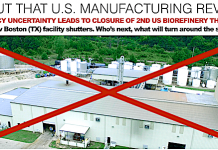Tom Konrad CFA
FutureFuel Corp. (NYSE:FF) manufactures chemicals, biofuels (mostly biodiesel), and other biobased products. About 60% of revenues have historically come from the Chemicals unit, with the balance of 40% coming from the Biodiesel unit. Both units saw sharp declines in revenues over the last two quarters for reasons that seem likely to be temporary (at least in part.) The stock has sold off sharply as a result, falling from the $18-$21 range this spring to its $12 recent price
Biodiesel
The entire biodiesel industry has been suffering from the expiration of the biodiesel blender’s tax credit and the long-delayed release of the EPA’s renewables fuels requirements. For the first time since they went into effect in 2007, the EPA proposed to cut the amount of biofuel that oil refiners must blend into their products, known as the Renewable Volume Obligations (RVO). The ensuing controversy (with biofuels producers arguing against cuts against strong oil industry opposition) has led the EPA to delay the release of the 2014 target.
According to Jim Lane, Publisher of Biofuels Digest in an interview, the EPA is directed to release the annual RVO by November first of the prior year. That means that the 2014 RVO are already over 11 months late. Lane expects them to be released this month. The other major incentive for biodiesel is the blender’s tax credit (BTC), a $1 per gallon credit given to fuel blender for every gallon of biodiesel blended with any amount of petrodiesel. This credit expired at the end of 2013, and has not been renewed. Most observers believe that it will not be renewed until the lame-duck session of Congress after the election in November, during which renewal is a possibility. Past renewals have been retroactive: In 2013, FutureFuel received a $2.5 million benefit from the retroactive reinstatement of the BTC for 2012.
The lack of the BTC and long delay of the RVO have led to a tough climate for both biodiesel producers and blenders. This is despite several positive developments Lane has observed. He says the popularity for biodiesel is high, and more and more companies are approving biodiesel blends for use in their vehicles.
Without the incentives, FutureFuel reduced biodiesel production dramatically in the second quarter, as did most biodiesel producers. This lead to dislocation in the market for biodiesel feedstocks: grease and oils. Lee Mikles, FutureFuel’s President observed in the second quarter conference call:
The feedstock availability is more robust right now than it had been… earlier in the year. You had a lot of feedstocks going offshore, it appeared to us, especially in the grease markets. … [T]here’s been a big dislocation in the market all of a sudden that has dropped these feedstock prices pretty dramatically. With soy coming down so dramatically, it helps a lot because that’s the easiest feedstock to use if anybody uses it. Typically we don’t because it’s too high priced, but all of a sudden you’ve got this unlocking of feedstocks kind of across the board because everything kind of track soy, more or less. …
I think there’s big opportunities in the back end of the year if you have the storage to be able to take it, which we do.
With the RVO likely to be released this month, and FutureFuel having been stockpiling cheap feedstock for the last few months, I expect that the fourth quarter will be extremely profitable for FutureFuel’s biodiesel business. Demand will be very high as customers scramble to fulfill their RVO in the last three months of the year. If the BTC is renewed retroactively during Congress’s lame duck session, we will see an added boost to profits in late 2014 or early 2015.
Chemicals
FutureFuel is also a manufacturer of specialty chemicals, and that side of the business has also been suffering. In this case, the problems have been mostly “self-inflicted,” as Mikles described them.
[W]e are a chemical plant and our efforts to implement new chemical growth has not been what we’d hoped for. We’ve really struggled to bring up a new proprietary herbicide intermediate plant and in executing sales for new customers – not existing, new customers on the laundry detergent additive. These have terrific potential, but we have not delivered on them so far.
In addition, we had hoped to have a refined glycerin plant operating in the second quarter, but we were not able to make that happen. The expectation, though, is that that plant will be ready in the not-too-distant future. The timing of that is really uncertain, but I can say that it is progressing positively at this point.
So we continue to see declines in our larger contracts – that’s not anything new, that’s continued to press forward, but we endeavor to replace that, those reductions, and to build our product portfolio. We do remain optimistic about the future prospects.
While I don’t have the expertise to evaluate the future prospects of a chemical plant, this sounds like it should also lead to significant business improvement in the next few quarters.
Insider Sentiment
When evaluating small companies, I put special weight on management and other insiders putting their own money on the line. While an insider might sell stock because they need the money for other reasons, the only reason for an insider to buy is because they think the market price undervalues the company’s current prospects.
According to SEC filings, insiders were last selling the stock in March, at around $20 a share. There have been no sales since then, but an Executive Vice President bought 1500 shares at $16 a share in May, and a director bought 5,000 shares at $14 in August. Since the price is currently $12, I think we can reasonably expect more insider buying after third quarter results are released and insiders are again able to trade the stock.
Conclusion
FutureFuel has two major business segments, and the stock has fallen by almost half since its peaks in March and April. The EPA’s release of the 2014 RVO this month, the possible renewal of the BTC during Congress’s lame duck session, and the likely improvements in the company’s Chemicals business over the next few quarters all lead me to expect strong increases in the company’s profits over the next few quarters.
The current price of $12 seems likely to be a relatively short lived buying opportunity. The recent downtrend could easily be reversed if the 2014 RVO are higher than most observers expect, or by less dismal than expected third quarter results, when they are released in November.
Even in the current climate, FutureFuel remains profitable and has a strong balance sheet. If Federal incentives for biodiesel are removed permanently, the biodiesel industry will survive as feedstock prices fall to reflect the drop in subsidized demand. If that his the case, FutureFuel will likely be a consolidator, with the opportunity to purchase biodiesel production capacity at pennies on the dollar from its less well-capitalized competitors.
Disclosure: Long FF.
DISCLAIMER: Past performance is not a guarantee or a reliable indicator of future results. This article contains the current opinions of the author and such opinions are subject to change without notice. This article has been distributed for informational purposes only. Forecasts, estimates, and certain information contained herein should not be
considered as investment advice or a recommendation of any particular security, strategy or investment product. Information contained herein has been obtained from sources believed to be reliable, but not guaranteed.







